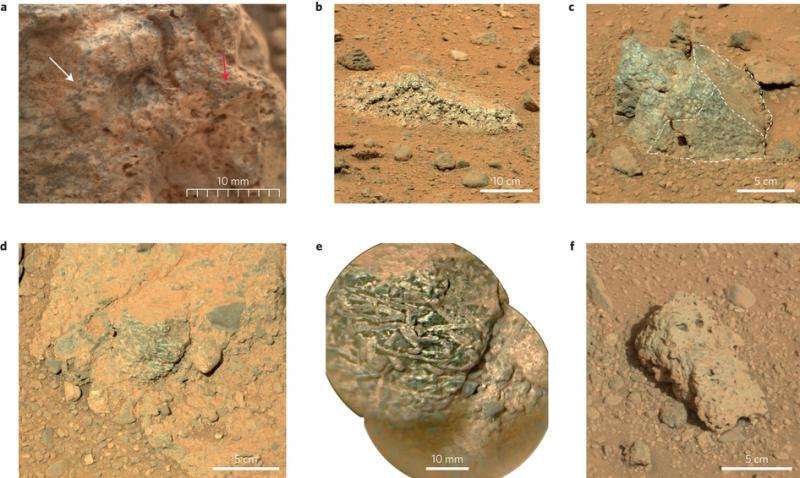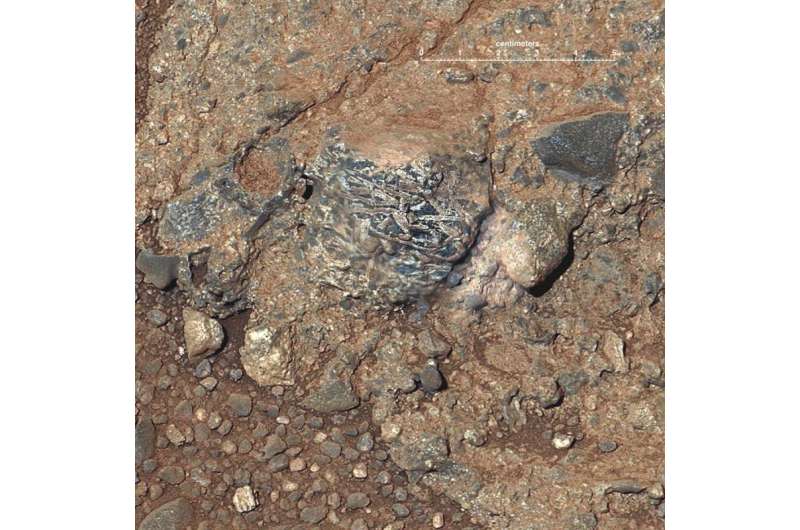July 14, 2015 report
Curiosity finds rocks that might point to a continental crust on Mars

(Phys.org)—A team of researchers from the U.S., France and the U.K. is reporting that data sent back by the Mars rover Curiosity suggests that the Red Planet may have once had a continental crust similar to that found back here on planet Earth. In their paper published in the journal Nature Geoscience, the team describes their analysis of data describing 20 rocks that had been probed by the rover, and why their findings suggest a different history for the planet than has been thought.
With all the excitement and news coming from the New Horizons probe as it conducts a flyby of Pluto, it is easy to forget that the Mars rover Curiosity is still active and still sending back valuable information. In this latest bit of news, researchers studying data sent back from the probe believe they have found evidence that suggests that rather than a lack of magmatic planetary activity, which should have been evident in rock samples showing mostly basalt, rock samples are full of silica and have a rich composition.
The light-colored rock samples are from an area inside the Gale Crater (in the southern hemisphere near Mount Sharp) and have been dated back to approximately 3.6 billion years ago. The researchers describe the rocks as looking like mineral composition samples taken from Earth, a huge departure from the dark basalt that was expected. The similarity suggests the planet may once have experienced plate tectonics similar to that on Earth. Up until now, the assumption has been that Mars did not have magmatic activity, which it is believed would have been necessary for the development of plates. That would have left the surface covered with basalt, similar to the situation at the bottom of our own world's oceans. The researchers note that for some of the rocks the ingredients are actually very similar to some of the oldest continental materials on Earth.

The findings do not confirm magmatic activity on the planet or the existence of tectonic plates, the researchers acknowledge, they simply suggest it might have been a possibility. The rock samples could have come to be the way they are, for example, by the partial melting of basalts as they sank back into the crust. As always, more research will be needed to truly understand the history of the rocks.
More information: In situ evidence for continental crust on early Mars, Nature Geoscience (2015) DOI: 10.1038/ngeo2474
Abstract
Understanding of the geologic evolution of Mars has been greatly improved by recent orbital, in situ and meteorite data, but insights into the earliest period of Martian magmatism (4.1 to 3.7 billion years ago) remain scarce9. The landing site of NASA's Curiosity rover, Gale crater, which formed 3.61 billion years ago within older terrain, provides a window into this earliest igneous history. Along its traverse, Curiosity has discovered light-toned rocks that contrast with basaltic samples found in younger regions. Here we present geochemical data and images of 22 specimens analysed by Curiosity that demonstrate that these light-toned materials are feldspar-rich magmatic rocks. The rocks belong to two distinct geochemical types: alkaline compositions containing up to 67 wt% SiO2 and 14 wt% total alkalis (Na2O + K2O) with fine-grained to porphyritic textures on the one hand, and coarser-grained textures consistent with quartz diorite and granodiorite on the other hand. Our analysis reveals unexpected magmatic diversity and the widespread presence of silica- and feldspar-rich materials in the vicinity of the landing site at Gale crater. Combined with the identification of feldspar-rich rocks elsewhere and the low average density of the crust in the Martian southern hemisphere, we conclude that silica-rich magmatic rocks may constitute a significant fraction of ancient Martian crust and may be analogous to the earliest continental crust on Earth.
Journal information: Nature Geoscience
© 2015 Phys.org




















